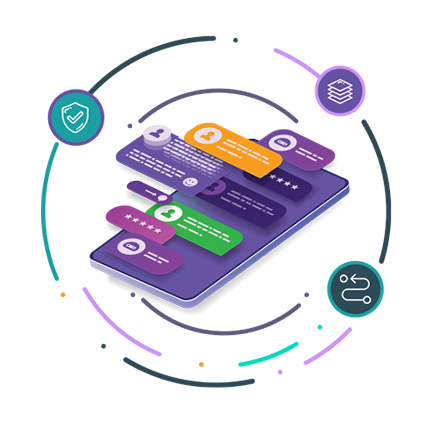As the global rollout of 5G accelerates, telecom operators find themselves at a critical inflection point. The fifth generation of wireless technology isn’t just about faster speeds, it’s about enabling ultra-low latency, massive device connectivity, and cloud-native services that demand agility from every part of the network. From autonomous vehicles to real-time remote surgery, 5G is powering a new generation of mission-critical applications.
Yet, amid the excitement around edge computing, private networks, and 5G-enabled devices, one key component often gets overlooked, SMSC infrastructure.
Though considered a legacy system by some, the Short Message Service Center remains a core part of mobile messaging infrastructure. It continues to power high-volume, time-sensitive communications like banking alerts, two-factor authentication codes, transaction confirmations, logistics notifications, and emergency broadcasts. As 5G redefines connectivity with distributed architectures and new service paradigms, the readiness of your SMSC can directly impact your network’s reliability, security, and enterprise messaging revenue.
A modernized SMSC bridges this gap. It allows operators to preserve the simplicity and ubiquity of SMS, while upgrading performance and security to meet modern demands.
Key Capabilities of a 5G-Ready SMSC:
According to hSenid R&D, telecoms that migrated to virtualized messaging platforms experienced a 60% reduction in delivery failures and launched new enterprise messaging services 30% faster.
Core Features Include:
These features don’t just future-proof your architecture, they enable you to actively monetize messaging as a service, which is becoming an increasingly important revenue stream as voice usage declines.
As customer experience becomes a defining factor in brand loyalty, enterprises are investing more in reliable communication. A modern SMSC empowers telecom operators to support this shift by offering scalable, secure messaging solutions that integrate easily into enterprise workflows. This turns the SMS platform into a profit center, where businesses can subscribe to high-availability messaging services tailored to their needs.
In a 5G environment, SMS supports:
A modern SMSC empowers operators to provide:
These capabilities open doors to sustainable new revenue streams in a market increasingly focused on data and service value rather than voice ARPU.
A 5G-capable messaging platform must provide:
Security isn’t a feature, it’s a necessity. And with 5G’s speed and scale, a modern messaging platform must keep up with more complex threats in real time.
A 5G-ready platform must offer elasticity, IP compatibility, secure APIs, and deep visibility into traffic patterns. It should empower operators to grow their enterprise business, serve millions of users reliably, and secure their place in an industry driven by speed and data.
If your current messaging system is holding you back, now is the time to modernize.
To explore a future-ready SMSC solution designed for 5G networks, visit our website and discover how hSenid Mobile is helping telecoms lead in intelligent messaging.
Yet, amid the excitement around edge computing, private networks, and 5G-enabled devices, one key component often gets overlooked, SMSC infrastructure.
Though considered a legacy system by some, the Short Message Service Center remains a core part of mobile messaging infrastructure. It continues to power high-volume, time-sensitive communications like banking alerts, two-factor authentication codes, transaction confirmations, logistics notifications, and emergency broadcasts. As 5G redefines connectivity with distributed architectures and new service paradigms, the readiness of your SMSC can directly impact your network’s reliability, security, and enterprise messaging revenue.
Why SMSC Modernization Matters in 5G
To appreciate the urgency of modernization, it’s important to understand what’s changing within telecom networks. 5G isn’t a simple upgrade from 4G, it’s a full transformation. The architecture is service-based, distributed, and highly dynamic. It demands a network core that can adapt, scale, and respond in real time. Traditional circuit-switched systems, like legacy SMSC hardware, weren’t built for this level of responsiveness.A modernized SMSC bridges this gap. It allows operators to preserve the simplicity and ubiquity of SMS, while upgrading performance and security to meet modern demands.
Key Capabilities of a 5G-Ready SMSC:
- Support for IMS and SIP protocols
- Integration with VoLTE and 5G core
- API-based connectivity to enterprise services
- Real-time analytics and smart message routing
According to hSenid R&D, telecoms that migrated to virtualized messaging platforms experienced a 60% reduction in delivery failures and launched new enterprise messaging services 30% faster.
What to Look For in a 5G-Ready SMS Platform
Modernizing your SMSC is more than a backend upgrade, it’s a strategic investment. Your platform must align with the architecture and economics of 5G.Core Features Include:
- Elastic scalability to handle peak traffic
- Geo-redundancy for uninterrupted delivery
- Fraud protection with real-time filtering and alerts
- Cloud-native deployment using containers and orchestration tools
- Support for both legacy and modern protocols, from SS7 to REST and HTTP
These features don’t just future-proof your architecture, they enable you to actively monetize messaging as a service, which is becoming an increasingly important revenue stream as voice usage declines.
Enterprise Messaging Opportunities in a 5G World
While apps like WhatsApp and iMessage dominate personal messaging, SMS continues to serve as the backbone of enterprise communication. Its reliability, global reach, and independence from mobile data make it ideal for high-stakes business use.As customer experience becomes a defining factor in brand loyalty, enterprises are investing more in reliable communication. A modern SMSC empowers telecom operators to support this shift by offering scalable, secure messaging solutions that integrate easily into enterprise workflows. This turns the SMS platform into a profit center, where businesses can subscribe to high-availability messaging services tailored to their needs.
In a 5G environment, SMS supports:
- Healthcare alerts for appointment reminders and urgent updates
- IoT device triggers and notifications in industrial or field settings
- Emergency messaging from government or public safety agencies
- Logistics updates for last-mile delivery and fleet coordination
A modern SMSC empowers operators to provide:
- Business messaging APIs for seamless enterprise integration
- Verified sender IDs that build consumer trust
- Routing intelligence to optimize delivery speed and cost
- Flexible pricing plans for SMEs and large enterprises
These capabilities open doors to sustainable new revenue streams in a market increasingly focused on data and service value rather than voice ARPU.
Security and Regulatory Considerations
With increasing message volumes comes increased risk. Fraudulent traffic, phishing scams, grey routing, and spoofing are all on the rise. The messaging layer must evolve to ensure safe, compliant delivery across all environments.A 5G-capable messaging platform must provide:
- Traffic firewalls to detect and block abnormal flows
- Role-based access control and audit trails for transparency
- Real-time monitoring with AI-based fraud detection
- Compliance with international and regional regulations including GDPR, HIPAA, and local telco rules
Security isn’t a feature, it’s a necessity. And with 5G’s speed and scale, a modern messaging platform must keep up with more complex threats in real time.
Conclusion: Future-Proofing Your Messaging Layer
As telecom networks evolve toward 5G, the infrastructure supporting them must evolve as well. Messaging might seem basic, but it’s still one of the most reliable and universal communication tools available. An outdated SMSC isn’t just inefficient, it could become a critical failure point as networks scale and diversify.A 5G-ready platform must offer elasticity, IP compatibility, secure APIs, and deep visibility into traffic patterns. It should empower operators to grow their enterprise business, serve millions of users reliably, and secure their place in an industry driven by speed and data.
If your current messaging system is holding you back, now is the time to modernize.
To explore a future-ready SMSC solution designed for 5G networks, visit our website and discover how hSenid Mobile is helping telecoms lead in intelligent messaging.








